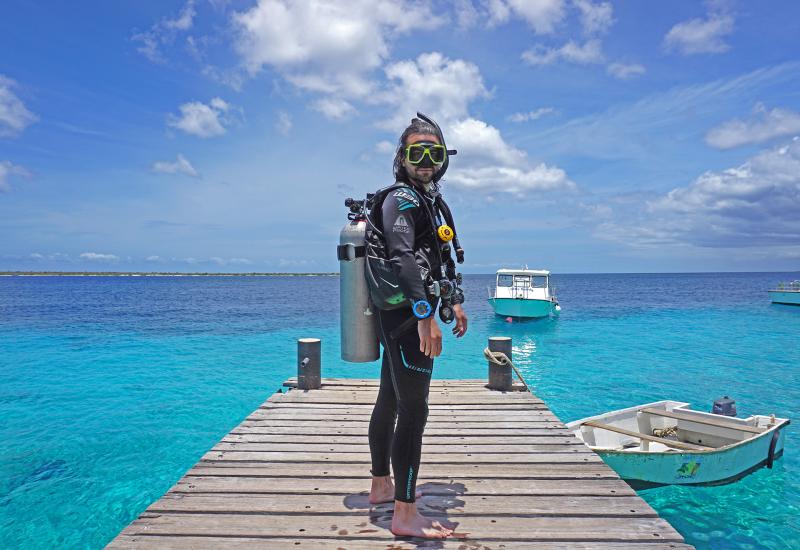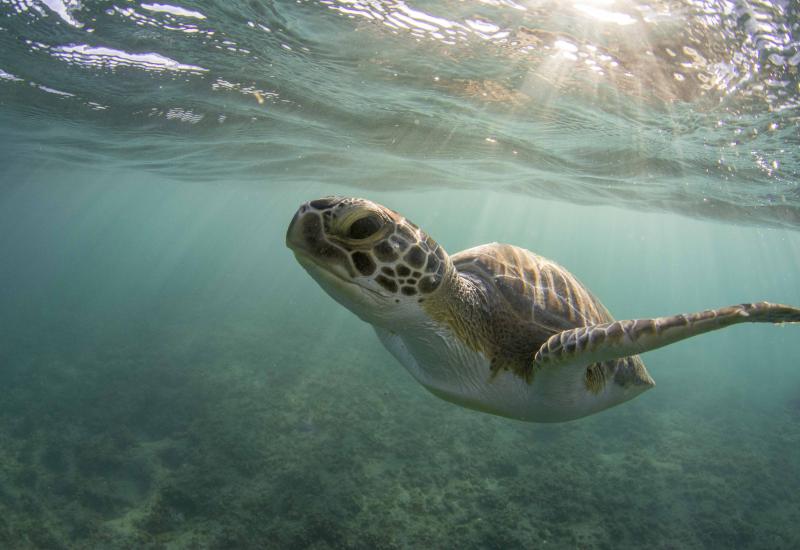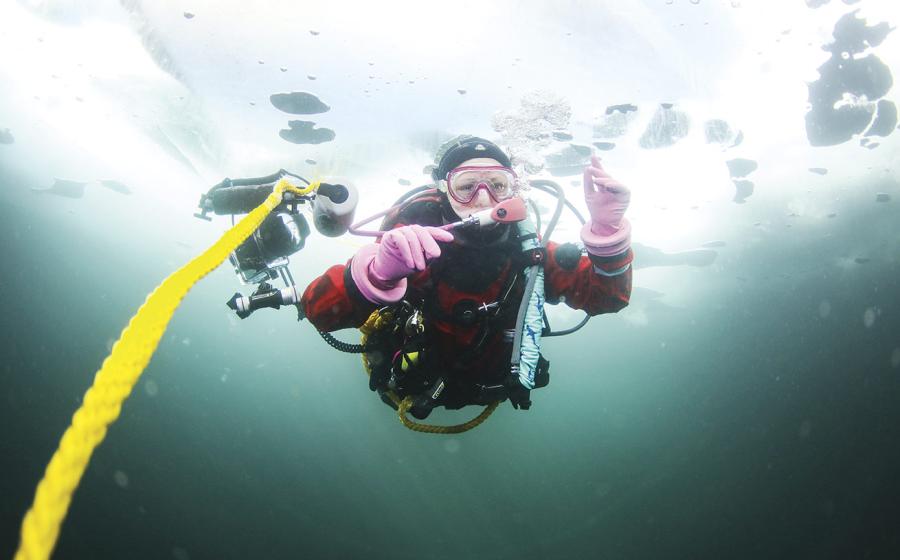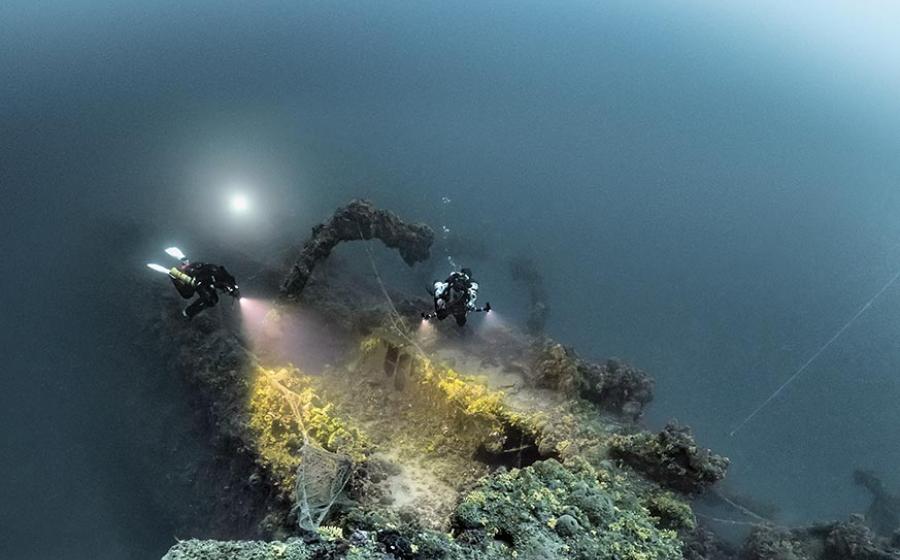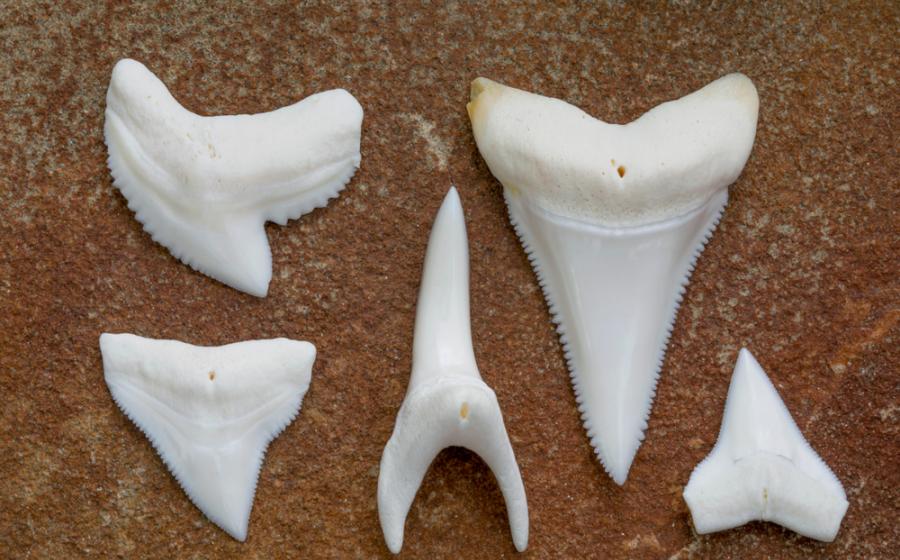Get the Lead Off
Don't you hate that divemaster suiting up with four pounds on his weight belt while you've got 20 pounds of lead punishing your hips just so you can get below the surface? How does he do it, swallow fishing sinkers? And what's with this fetish for lightening the load, anyway? Isn't that what buoyancy compensators are for?
Well, actually, no. The role of the BC is to compensate for changes in buoyancy during the dive, not to float lead you don't need in the first place. Chances are you not only can, but should, take off some weight. "Well over 50 percent of average recreational divers are overweighted," says Tec Clark, associate director of the YMCA scuba program.
Too Much of a Good Thing
Too much weight may make it easier to break the surface, but it also makes buoyancy harder to control. The negative buoyancy of the extra lead is constant regardless of depth, while the buoyancy of the air you put into your BC to support that lead varies with depth. The two are always getting out of balance.
Say you're five pounds heavy. At 40 feet, you inject enough air into your BC to create five pounds of lift, making you neutral. If you descend farther, the increasing water pressure compresses the air bubble in your BC. Now it displaces less water and therefore creates less lift, say two pounds. But five pounds of lead is still five pounds of lead, leaving you three pounds heavy.
On the other hand, if you ascend from that 40-foot depth, the air bubble in your BC expands, displacing more water and creating more lift, say eight pounds. Now you're three pounds too light and headed up.
What's worse, this is a problem that feeds itself. For example, if you're three pounds light and start ascending, the air bubble in your BC starts growing and generating even more lift. Three pounds of buoyant lift becomes four, five, seven, 10 and so on. Your ascent gains speed--the more you ascend, the faster you ascend. It's the same, of course, when you're too heavy: With each foot, your descent accelerates.
Think Miniature Golf
Ever played miniature golf? There's always a hole exactly at the top of a beehive-shaped hill. You have to tap the ball just hard enough to pause at the top before it can sink in. That's neutral buoyancy. Tap too hard or too soft and it creeps off the summit, then rolls faster and faster down the hill, picking up speed with every foot. That's negative or positive buoyancy increasing with depth changes.
Can you solve the problem by venting air from your BC when you start ascending, or adding air when you begin to sink? Yes, you can and should. That's like tapping the ball back to the top of the hill as soon as it begins to roll.
Unfortunately, most divers overcorrect--they tap the ball too hard so it rolls over the top and down the other side. Heavy objects like divers don't change direction in water as quickly as we expect, so when one toot on the inflate button doesn't produce an immediate result, we go for a long honk. In fact, that first toot might have been enough had we waited for it to take effect.
Carrying extra weight is like making the sides of that beehive hill steeper and the summit--the point of neutral buoyancy--smaller. On the other hand, the closer you get to correct weighting the flatter that hill becomes, and the easier it is to keep the ball on the top. To get your buoyancy under control, you need to minimize the air bubble you're carrying with you. And to do that you need to minimize the lead.
The Goal: Just Enough Lead
How many pounds do you need? The answer is different for every diver, for every equipment combination and to some extent for every day.
The goal, however, is the same for everyone: to carry the minimum amount of weight that allows you to be neutral at 15 feet with an empty BC and a nearly empty tank. In other words, while you're making your safety stop at the end of the dive. The reason is obvious: You've got to hover there quietly for three to five minutes.
Why does the depth matter? Because your exposure suit acts like a BC. The thousands of tiny bubbles in a neoprene suit, or the one big bubble in a shell dry suit, expand and contract with depth, gaining and losing buoyancy. In general, a men's neoprene jumpsuit has two to three pounds of buoyancy at the surface for each millimeter of thickness.
Why does the psi matter? Because air has weight though the size of the tank doesn't change. The air in a standard aluminum 80-cubic-foot cylinder weighs about six pounds. Breathe it down from 3,000 psi to 500 psi, and it weighs about five pounds less. Now you are five pounds more buoyant.
Incidentally, it is not true that steel tanks do not become lighter. Being heavier to begin with, they may still be negative at the end of the dive, but they also gain about a pound of buoyancy for each 13 cubic feet you breathe out of them.
Minimum Weight: How Do You Get There?
OK, you need enough weight to be neutral during the safety stop. How much is that? You've heard of ways to make ballpark estimates of how much weight you need, but they are all pretty big ballparks:
-
Carry 10 percent of your body weight in lead.
-
In full scuba gear, add weight until you float with the water at your eye level. (Some would say, "at your hairline.")
-
In full scuba gear, add lead until you sink "gently."
Here's how you can reduce that ballpark estimate to the size of the infield, if not smaller, and do it before your first dive. You don't need to waste dive time, hold up your buddy or contribute to the entertainment of the boat crew.
-
1) Go snorkeling. Get in the water with mask, fins, snorkel, the exposure suit you will be using and a weight belt loaded per one of those ballpark estimates.
-
2) Kick down to about 10 feet, level out, exhale about half your breath and see if you rise or fall.
-
3) Adjust. Return to the dock or the beach and adjust the amount of weight until you can hover at 10 feet.
-
4) Add five pounds. This compensates for the positive buoyancy of a standard 80-cubic-foot aluminum tank.
This method should get you within three or four pounds of the right weight, and you'll probably end up a few pounds on the heavy side because regulators and the instruments are generally negative by a pound or two. Your BC is nearly neutral.
Fine-tuning Your Weight Total
Start your dive. Too light? Don't be so sure until you've dealt with air in the BC and the exposure suit, anxiety, etc. Too heavy? Again, don't be so sure. You should be about five pounds heavy because of the weight of air in your tank.
Accurate fine-tuning of your weight total is best done at the end of a dive, during your safety stop at about 15 feet with about 500 psi in your tank. Presumably, you're as calm as you're going to be by this time. All the stray bubbles will have been driven out of your wetsuit by now. And with your tank nearly empty, you are at your maximum buoyancy--you need just enough lead to be neutral at this point.
How to Get Down: Tips from the Pros
The divemaster may think you're overweighted, but that can be hard to swallow when you're bobbing at the side of the boat, unable to get beneath the surface. In that case you obviously need more lead, not less, right?
Maybe not. Without realizing it, many divers create unnecessary buoyancy or upward thrust, then counter it with unnecessary lead. Here's why:
1) ANXIETY FLOATS. Anxious divers tend to move their hands and feet more, and that propels them upward. This is one reason why new divers are more likely to be overweighted than vets: they try to overcome nervous finning by loading up on lead.
Try this: Tuck your fins up under your butt and grab your ankles. That immobilizes both hands and feet. Or "keep your arms close to your body and toes pointed to create less resistance," says SSI Instructor Certifier Daryl Bauer.
2) AIR IN YOUR BC. You may think you've dumped all the air--you may be holding the dump button down--but many BCs will still hold a large bubble of air. The problem is that the BC is flexible and can balloon in different directions.
Try this: Hold the valve as high as you can with your left hand so the corrugated hose is fully extended. At the same time, says Linda Van Velson, a PADI course director, "dip your right shoulder and squeeze the BC against your chest with your right arm."
Scuba Lab has found that many BCs trap a bubble of air behind your head. It's especially common with back-buoyancy BCs, which tend to pitch you forward on the surface. You can check by reaching behind your head to feel for a "pillow."
Try this: While holding the exhaust valve open, rock backward a little as if you were settling into a La-Z-Boy recliner. This gets the valve on top of the bubble.
3) AIR IN YOUR EXPOSURE SUIT. Dry suit divers are especially aware of this problem because the bubble trapped in a dry suit can be so large. At the end of a dive, a diver in a shell suit looks shrink-wrapped if he is correctly weighted and inflated--he needs only enough air in the suit to maintain the pile of his thermal wear. That's a degree of air-evacuation impossible to achieve by any bend-over-and-hug-yourself contortions before the dive. Only water pressure will do it.
Try this: NAUI Course Director Bill Kendig suggests walking down the swim ladder until the water is almost to your neck, then opening the neck seal with a finger to let the air out. But be careful you don't get the seal below the surface!
Even wetsuits retain some air at first, in the form of thousands of tiny bubbles trapped in the weave of the suit's lining, as well as larger bubbles in your armpits and groin. Plush-lined suits trap more air; smooth-lined suits trap less.
Try this: Be patient. Wait a few minutes for the water to fully soak the inside of your suit. Help it along by opening the neck seal with a finger or, if you have a will of iron, opening a zipper. Moving your arms and legs at the same time may work the bubbles upward faster. Burp your hood, too, or make a vent hole in its top. It's perfectly shaped to be an unintended lift bag.
4) AIR IN YOUR LUNGS. It's natural to enter the water with your lungs full of air. What many divers don't realize is that even after entering, and for the first few minutes until they begin to relax, they are breathing from the "top half" of their lungs. That is, they are exhaling only halfway, then refilling their lungs on the inhale. The result is extra buoyancy, as well as the risk of carbon dioxide buildup if they continue this breathing pattern too long.
Try this: When you're ready to descend from the surface, exhale as long as you can, breathing out until you've sunk several feet. Make your first inhale a shallow one until you're a few feet down, then breathe normally.
Don't you hate that divemaster suiting up with four pounds on his weight belt while you've got 20 pounds of lead punishing your hips just so you can get below the surface? How does he do it, swallow fishing sinkers? And what's with this fetish for lightening the load, anyway? Isn't that what buoyancy compensators are for?
Well, actually, no. The role of the BC is to compensate for changes in buoyancy during the dive, not to float lead you don't need in the first place. Chances are you not only can, but should, take off some weight. "Well over 50 percent of average recreational divers are overweighted," says Tec Clark, associate director of the YMCA scuba program.
Too Much of a Good Thing
Too much weight may make it easier to break the surface, but it also makes buoyancy harder to control. The negative buoyancy of the extra lead is constant regardless of depth, while the buoyancy of the air you put into your BC to support that lead varies with depth. The two are always getting out of balance.
Say you're five pounds heavy. At 40 feet, you inject enough air into your BC to create five pounds of lift, making you neutral. If you descend farther, the increasing water pressure compresses the air bubble in your BC. Now it displaces less water and therefore creates less lift, say two pounds. But five pounds of lead is still five pounds of lead, leaving you three pounds heavy.
On the other hand, if you ascend from that 40-foot depth, the air bubble in your BC expands, displacing more water and creating more lift, say eight pounds. Now you're three pounds too light and headed up.
What's worse, this is a problem that feeds itself. For example, if you're three pounds light and start ascending, the air bubble in your BC starts growing and generating even more lift. Three pounds of buoyant lift becomes four, five, seven, 10 and so on. Your ascent gains speed--the more you ascend, the faster you ascend. It's the same, of course, when you're too heavy: With each foot, your descent accelerates.
Think Miniature Golf
Ever played miniature golf? There's always a hole exactly at the top of a beehive-shaped hill. You have to tap the ball just hard enough to pause at the top before it can sink in. That's neutral buoyancy. Tap too hard or too soft and it creeps off the summit, then rolls faster and faster down the hill, picking up speed with every foot. That's negative or positive buoyancy increasing with depth changes.
Can you solve the problem by venting air from your BC when you start ascending, or adding air when you begin to sink? Yes, you can and should. That's like tapping the ball back to the top of the hill as soon as it begins to roll.
Unfortunately, most divers overcorrect--they tap the ball too hard so it rolls over the top and down the other side. Heavy objects like divers don't change direction in water as quickly as we expect, so when one toot on the inflate button doesn't produce an immediate result, we go for a long honk. In fact, that first toot might have been enough had we waited for it to take effect.
Carrying extra weight is like making the sides of that beehive hill steeper and the summit--the point of neutral buoyancy--smaller. On the other hand, the closer you get to correct weighting the flatter that hill becomes, and the easier it is to keep the ball on the top. To get your buoyancy under control, you need to minimize the air bubble you're carrying with you. And to do that you need to minimize the lead.
The Goal: Just Enough Lead
How many pounds do you need? The answer is different for every diver, for every equipment combination and to some extent for every day.
The goal, however, is the same for everyone: to carry the minimum amount of weight that allows you to be neutral at 15 feet with an empty BC and a nearly empty tank. In other words, while you're making your safety stop at the end of the dive. The reason is obvious: You've got to hover there quietly for three to five minutes.
Why does the depth matter? Because your exposure suit acts like a BC. The thousands of tiny bubbles in a neoprene suit, or the one big bubble in a shell dry suit, expand and contract with depth, gaining and losing buoyancy. In general, a men's neoprene jumpsuit has two to three pounds of buoyancy at the surface for each millimeter of thickness.
Why does the psi matter? Because air has weight though the size of the tank doesn't change. The air in a standard aluminum 80-cubic-foot cylinder weighs about six pounds. Breathe it down from 3,000 psi to 500 psi, and it weighs about five pounds less. Now you are five pounds more buoyant.
Incidentally, it is not true that steel tanks do not become lighter. Being heavier to begin with, they may still be negative at the end of the dive, but they also gain about a pound of buoyancy for each 13 cubic feet you breathe out of them.
Minimum Weight: How Do You Get There?
OK, you need enough weight to be neutral during the safety stop. How much is that? You've heard of ways to make ballpark estimates of how much weight you need, but they are all pretty big ballparks:
Carry 10 percent of your body weight in lead.
In full scuba gear, add weight until you float with the water at your eye level. (Some would say, "at your hairline.")
In full scuba gear, add lead until you sink "gently."
Here's how you can reduce that ballpark estimate to the size of the infield, if not smaller, and do it before your first dive. You don't need to waste dive time, hold up your buddy or contribute to the entertainment of the boat crew.
1) Go snorkeling. Get in the water with mask, fins, snorkel, the exposure suit you will be using and a weight belt loaded per one of those ballpark estimates.
2) Kick down to about 10 feet, level out, exhale about half your breath and see if you rise or fall.
3) Adjust. Return to the dock or the beach and adjust the amount of weight until you can hover at 10 feet.
4) Add five pounds. This compensates for the positive buoyancy of a standard 80-cubic-foot aluminum tank.
This method should get you within three or four pounds of the right weight, and you'll probably end up a few pounds on the heavy side because regulators and the instruments are generally negative by a pound or two. Your BC is nearly neutral.
Fine-tuning Your Weight Total
Start your dive. Too light? Don't be so sure until you've dealt with air in the BC and the exposure suit, anxiety, etc. Too heavy? Again, don't be so sure. You should be about five pounds heavy because of the weight of air in your tank.
Accurate fine-tuning of your weight total is best done at the end of a dive, during your safety stop at about 15 feet with about 500 psi in your tank. Presumably, you're as calm as you're going to be by this time. All the stray bubbles will have been driven out of your wetsuit by now. And with your tank nearly empty, you are at your maximum buoyancy--you need just enough lead to be neutral at this point.
How to Get Down: Tips from the Pros
The divemaster may think you're overweighted, but that can be hard to swallow when you're bobbing at the side of the boat, unable to get beneath the surface. In that case you obviously need more lead, not less, right?
Maybe not. Without realizing it, many divers create unnecessary buoyancy or upward thrust, then counter it with unnecessary lead. Here's why:
1) ANXIETY FLOATS. Anxious divers tend to move their hands and feet more, and that propels them upward. This is one reason why new divers are more likely to be overweighted than vets: they try to overcome nervous finning by loading up on lead.
Try this: Tuck your fins up under your butt and grab your ankles. That immobilizes both hands and feet. Or "keep your arms close to your body and toes pointed to create less resistance," says SSI Instructor Certifier Daryl Bauer.
2) AIR IN YOUR BC. You may think you've dumped all the air--you may be holding the dump button down--but many BCs will still hold a large bubble of air. The problem is that the BC is flexible and can balloon in different directions.
Try this: Hold the valve as high as you can with your left hand so the corrugated hose is fully extended. At the same time, says Linda Van Velson, a PADI course director, "dip your right shoulder and squeeze the BC against your chest with your right arm."
Scuba Lab has found that many BCs trap a bubble of air behind your head. It's especially common with back-buoyancy BCs, which tend to pitch you forward on the surface. You can check by reaching behind your head to feel for a "pillow."
Try this: While holding the exhaust valve open, rock backward a little as if you were settling into a La-Z-Boy recliner. This gets the valve on top of the bubble.
3) AIR IN YOUR EXPOSURE SUIT. Dry suit divers are especially aware of this problem because the bubble trapped in a dry suit can be so large. At the end of a dive, a diver in a shell suit looks shrink-wrapped if he is correctly weighted and inflated--he needs only enough air in the suit to maintain the pile of his thermal wear. That's a degree of air-evacuation impossible to achieve by any bend-over-and-hug-yourself contortions before the dive. Only water pressure will do it.
Try this: NAUI Course Director Bill Kendig suggests walking down the swim ladder until the water is almost to your neck, then opening the neck seal with a finger to let the air out. But be careful you don't get the seal below the surface!
Even wetsuits retain some air at first, in the form of thousands of tiny bubbles trapped in the weave of the suit's lining, as well as larger bubbles in your armpits and groin. Plush-lined suits trap more air; smooth-lined suits trap less.
Try this: Be patient. Wait a few minutes for the water to fully soak the inside of your suit. Help it along by opening the neck seal with a finger or, if you have a will of iron, opening a zipper. Moving your arms and legs at the same time may work the bubbles upward faster. Burp your hood, too, or make a vent hole in its top. It's perfectly shaped to be an unintended lift bag.
4) AIR IN YOUR LUNGS. It's natural to enter the water with your lungs full of air. What many divers don't realize is that even after entering, and for the first few minutes until they begin to relax, they are breathing from the "top half" of their lungs. That is, they are exhaling only halfway, then refilling their lungs on the inhale. The result is extra buoyancy, as well as the risk of carbon dioxide buildup if they continue this breathing pattern too long.
Try this: When you're ready to descend from the surface, exhale as long as you can, breathing out until you've sunk several feet. Make your first inhale a shallow one until you're a few feet down, then breathe normally.


